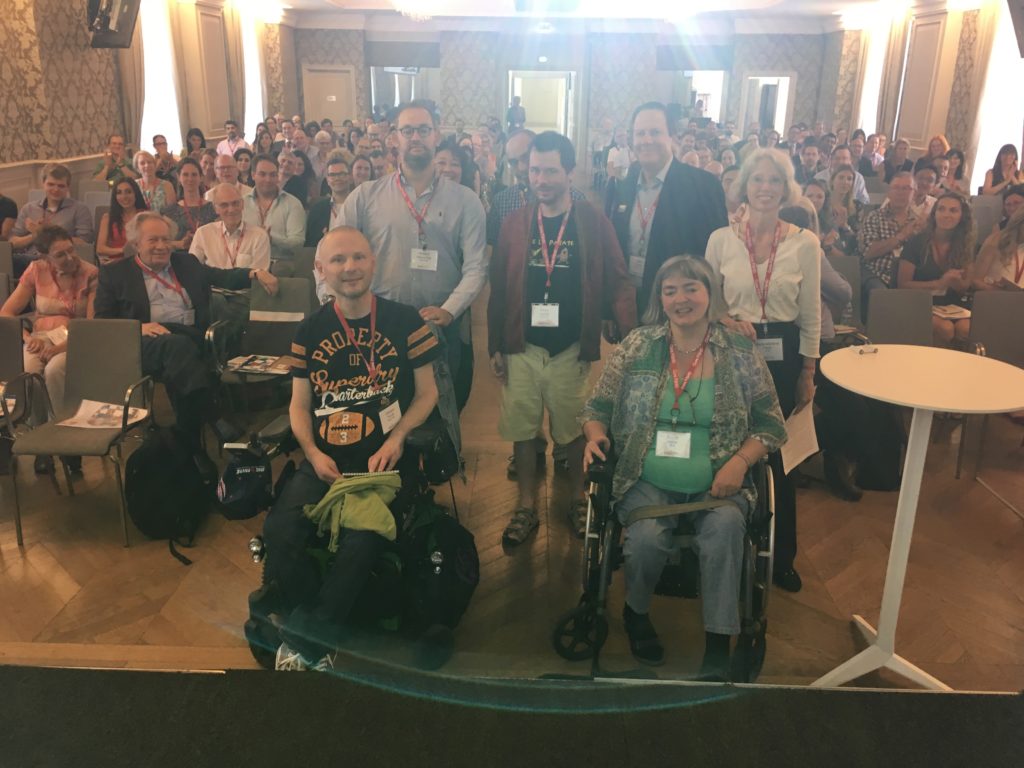At the 26th annual FSHD International Research Congress (IRC) this June 19-20, held in a 19th-century palace overlooking the harbor of Marseille, the 180 attendees were treated to a spectacular panorama of France’s second-largest city. From the massive 17th-century stone ramparts of Fort St. Jean to the cutting-edge architecture of the Museum of European and Mediterranean Civilisations, the view encompassed the ancient and the modern in this bustling Mediterranean port.
Similarly, the conference itself spanned the past and future of the FSHD field. In the first keynote, Michel Fardeau, the “father of muscle research in France” who founded what became the Institute of Myology in Paris, reflected on the historic work of Louis Landouzy and Joseph Dejerine, the neurologists who identified the hereditary muscle condition that was named for them (Landouzy-Dejerine disease) and came to be called facioscapulohumeral muscular dystrophy.
On the second day, keynote speaker Brad Cairns of the University of Utah School of Medicine described ground-breaking findings by his group and others of DUX4’s role as a “zygotic activator” gene that switches on the genetic program that launches the transformation of a four-cell zygote into an embryo and eventually a fully formed human being. DUX4 expression in adult skeletal muscle is implicated in the damage to muscle in FSHD, but the gene’s role in normal development is still being worked out; the connection, if any, between DUX4’s developmental and FSHD roles remains a mystery for future investigation.
Cairns described still-unpublished research indicating that in human development, DUX4 is switched on by the cell’s response to DNA damage that is “common” throughout the genome during fertilization, he said. Untangling the cause and effect of DUX4 activity during development could yield insights into the gene’s role in FSHD and new strategies to treat the condition.
One notable theme of this year’s IRC was the number of talks that discussed nongenetic triggers of FSHD, including hormones, oxidative stress, and, in particular, the immune response—something that just a few years ago was not considered to play a significant role. Talks given by Stephen Tapscott, Joel Chamberlain, and Anna Panamarova, among others, discussed evidence for the immune response in driving FSHD.
One intriguing manifestation of autoimmune mechanisms at work in FSHD was suggested by Sabrina Sacconi, MD, of Nice University Hospital. She reported that FSHD patients had an increased incidence of skin conditions such as atopic dermatitis, actinic keratosis, seborrheic dermatitis, and rosacea. Utilizing the French patient registry and social media, her team collected photos of 88 patients and analyzed them for skin conditions. “I initially doubted that there was a connection, but it seems to be prevalent,” Sacconi said. The prevalence of skin conditions among FSHD1 patients was 16 percent, while among patients with FSHD2 and FSHD1 combined with FSHD2, it was closer to 60 percent. She noted that the D4Z4-2.5 mouse model of FSHD develops skin lesions and that autoimmune mechanisms may be associated with the abnormal proliferation of keratinocytes (a type of skin cell).
Not surprisingly, there was keen interest in the talks about treatments that are getting closer to the clinic. Jeffrey Statland of the University of Kansas spoke about Acceleron’s ACE-083 clinical trial and reported that the drug, which is given through multiple muscle injections every three weeks, is “well tolerated over three months.” MRI data on the percentage of fat in muscle (a measurement of muscle loss) showed a linear correlation with muscle strength, function tests, and patient reports (collected through the FSHD-HI questionnaire). The placebo-controlled Phase 2b trial has recruited all of the patients needed, and the collection of data from these patients is expected to be completed over this summer.
Researchers from Fulcrum Therapeutics, which is launching a Phase 2b trial of losmapimod this summer, presented multiple talks and posters that described the data that led the company to select the drug as its lead candidate. The drug inhibits p38 mitogen-activated protein kinase (MAPK), which is involved in cells’ response to stress. Fulcrum’s studies showed that losmapimod reduced DUX4 protein as well as the genes that are activated by DUX4, and reduced cell death. At the same time, the drug has minimal negative effects on myogenesis (formation of muscle tissue from muscle stem cells).
In separate talks, Robert Bloch of the University of Maryland and Fran Sverdrup at St. Louis University presented data supporting the efficacy of p38 inhibitors in knocking down DUX4, providing independent validation of Fulcrum’s findings.
Joris De Maeyer of Facio Therapies presented an elaborate high-content screening platform that simultaneously measures DUX4 protein expression and several phenotypic endpoints in primary muscle cells. Upon screening 90,000 compounds, casein kinase I (CK1) was identified as a novel drug target and a tool inhibitor of CK1 was demonstrated to suppress DUX4 expression in FSHD myotubes and in a xenograft model of FSHD.
Other investigators, including Lindsay Wallace of Nationwide Children’s Hospital and Rika Maruyama of the University of Alberta, described methods for silencing DUX4 using various antisense approaches.
At this year’s IRC, for the first time, a prize was given for best poster. The program committee reviewed the 35 poster talks and awarded the prize to Gholamhossein Amini Chermahini, Afrooz Rashnonejad, MD, and Scott Q. Harper, PhD, from Nationwide Children’s Hospital in Columbus, Ohio. The researchers had invented a super-sensitive method for detecting DUX4 messenger RNA (mRNA) in muscle tissue. They noted that this task was “challenging, due to the low level of DUX4 expression.” The technique they developed, called an RNAscope assay, “was highly sensitive for tracking reductions in DUX4 mRNA following treatment with our therapeutic mi405 microRNA, suggesting that RNAscope-based DUX4 expression assays could be developed as a prospective outcome measure in therapy trials.”
Also, for the first time this year, the congress was opened by patients. Pierre Laurian and Marie-Martine Fleck spoke movingly about the lifelong impact of their condition. Afterward, congress attendees responding to a survey said this was one of the highlights of the meeting, a timely and powerful reminder, as one attendee said, that “for every researcher, whether they are working with cells or with patients, our main goal is to improve the life of the patients.”



Thanks a lot for that smart summary.
That’s why it did not hurt that much because I was not there.
Christoph
Wonderful article. Thank you.
Thank you so much for this!!
Do you know in which country/city will be the next IRC? I would love to assist!
The next IRC will be in the US.
My experience has been the 2X I got pneumonia my FSHD was made worse. Has there been any studies showing the adverse effects of pneumonia on FSHD MD ??
We’re not familiar with any such study, but researchers speculate that immune activation, which can happen in response to an infection, might contribute to the disease process in FSHD.